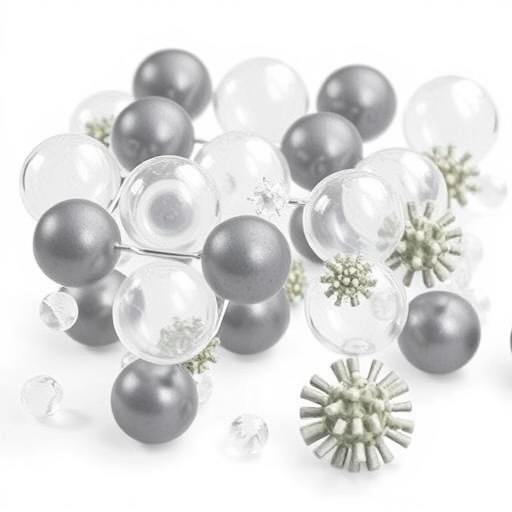Researchers have recently uncovered groundbreaking insights into the ionic conductivity of sodium aluminum iodide, specifically focusing on its compositionally modified variant, NaAlI₄. This fascinating study, led by a team of scientists including R. Miyazaki, K. Fukushima, and T. Hihara, has been published in the esteemed journal Ionics. The team meticulously examined the effects of bromide ion (Br⁻) substitution and the role of excess sodium ions (Na⁺) on the ionic conductivity of NaAlI₄, which could have significant implications for a range of applications in electrochemical devices.
Ionic conductivity is a critical property for materials used in batteries, fuel cells, and other electrochemical applications. The ability of ions to migrate through a solid-state medium efficiently often dictates the overall performance of these devices. With the primary role of sodium in energy-related applications and the growing interest in sodium-based materials, understanding how to manipulate ionic conductivity through compositional tuning is essential. The findings of this research elucidate pathways to enhance conductivity and provide a deeper understanding of the underlying mechanisms.
The study delved into the microstructural characteristics of NaAlI₄ when bromine substitutes for iodine, yielding intriguing results. Researchers found that the introduction of Br⁻ ions within the lattice altered the ionic pathways in the material, facilitating enhanced ionic transport. This substitution therapy not only improved conductivity but also introduced new electrochemical behavior, making NaAlI₄ a highly versatile material for energy applications.
Moreover, the excess addition of Na⁺ ions significantly impacted the ionic mobility, offering another avenue for conductivity enhancement. By carefully calibrating the amounts of Na⁺ present, the researchers could optimize the structural integrity and ionic pathways, pushing the limits of ionic transport. This dual strategy of mixing sodium ions and substituting halide ions has opened a new chapter in the study of solid electrolytes.
The experiments conducted employed advanced techniques such as X-ray diffraction and impedance spectroscopy, which provided a comprehensive understanding of how sodium and bromide ions influence the material’s ionic transport properties. Through these methodologies, the team could visualize the crystal lattice changes and the resultant ionic movement within the structure, establishing a clear link between composition and conductivity.
As the energy landscape continues to evolve, finding efficient materials for ion transport is crucial. The insights provided by Miyazaki, Fukushima, and Hihara suggest that the optimal ionic conductivity of NaAlI₄ could be achieved through targeted compositional changes, making it a potential candidate for next-generation solid-state batteries. The innovative approach of this research paves the way for the development of high-performance sodium-based electrolytes that could rival existing lithium alternatives.
The findings also resonate with the global shift towards more sustainable energy solutions. Sodium, being abundantly available, is a more environmentally friendly option compared to lithium, which is increasingly being scrutinized for its ecological footprint. This research not only contributes to scientific knowledge but also aligns with broader sustainability initiatives in the energy sector.
Furthermore, the implications of this study extend beyond merely academic pursuits. Industries focused on energy storage solutions may take cues from these findings to enhance their product offerings. By adopting the principles of compositional tuning, companies could potentially develop batteries with improved life cycles, faster charging capabilities, and greater overall efficiency.
The ongoing exploration into NaAlI₄ and its derivatives indicates a promising future for the manipulation of ionic conductivities through compositional engineering. As researchers continue to investigate materials with favorable ionic transport, the fundamental understanding gained from this study will undoubtedly influence design strategies in future research endeavors.
In summary, the groundbreaking work conducted by Miyazaki and colleagues lays a robust foundation for further exploration into the composition of sodium aluminum iodide. The systematic investigation into Br⁻ substitution and excess Na⁺ provides exciting prospects for enhancing ionic conductivity in solid electrolytes. This innovative study emphasizes the significance of tailored material compositions, presenting a paradigm that could reshape the future of energy storage technologies.
The variability in ionic conductivity resulting from compositional changes not only opens doors for scientific exploration but also emphasizes the importance of interdisciplinary approaches in material science. By harnessing insights from chemistry, materials science, and engineering, researchers are forging pathways towards innovations that could define future energy solutions.
The continued research fueled by the findings in this study will challenge existing paradigms and encourage the exploration of new materials. Given the urgency of addressing global energy challenges, the impact of these advancements cannot be overstated. The work of Miyazaki, Fukushima, and Hihara stands as a testament to the potential that lies in marrying theoretical insights with practical applications in material development.
In conclusion, the journey of NaAlI₄ as a promising candidate for advanced energy solutions is just beginning, driven by integrated research efforts and an unwavering commitment to sustainability.
Subject of Research: Ionic conductivity of sodium aluminum iodide and effects of bromide substitution along with excess sodium ions
Article Title: Compositional tuning of NaAlI₄: effects of Br⁻ substitution and excess Na⁺ on ionic conductivity.
Article References:
Miyazaki, R., Fukushima, K. & Hihara, T. Compositional tuning of NaAlI4: effects of Br⁻ substitution and excess Na+ on ionic conductivity.
Ionics (2025). https://doi.org/10.1007/s11581-025-06823-y
Image Credits: AI Generated
DOI:
Keywords: Sodium aluminum iodide, ionic conductivity, compositional tuning, bromide substitution, sodium ions, energy storage, solid electrolytes.




